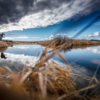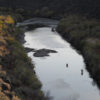“When it snows, you have two choices: shovel or make snow angels.” ~ Unknown

You have a third choice…go fly fishing. After a mild fall, snow has blessed the valley and the mountains making the transition on our waters to a winter fishery rather abrupt. And looking at the extended forecast, there is more snow on the way. So, if you decide to spend a day fly fishing, be sure to pack a set of chains, a shovel, a blanket, some food and water, a thermos, a flask, as well as extra clothing. There will be time for shoveling and snow angels later; the Conservancy portion of the Creek is only open till the end of the month!
SILVER CREEK
Even with the cold winter like conditions, the Creek will still produced decent Baetis and Midge action; however, it is short, isolated, and late in the day. Of course, cloudy days are your best bet for fish on the surface. The rest of the time, your best action will come on nymphs and streamers. For nymphs, try a beaded or non-beaded pheasant tail, a Zebra Midge, or a WD40 in size 20 or 22. Find the right depth with your dropper and you will take plenty of trout. Many browns are on in the shallows and spawning. Please leave these fish alone and don’t walk through the redds. There are plenty of other fish to pursue. Remember the Conservancy stretch and Purdy’s down to highway 20 will close at the end of November. From the Highway 20 bridge down through the Willows and the Point of Rocks the fishing will remain open until the end of February.
THE BIG WOOD
The cold weather in the valley has already concentrated the fish in the winter holding water and the hatches have been reduced to a few midge late in the day. Still the fish are hungry and if you find the right spot at the right time you will find fish. For flies, try a size 18 or 16 Zebra Midge, Rainbow Warrior or Bishop’s Dynamite or a larger size 8-12 Rubber Leg Stone, San Juan Worm, or a Czech style nymph. Dangle these bugs off a high floating dry, an indicator, or fish them Euro Style. The key to success when the water gets cold is to find the right depth. Remember that when the water temps drop, the takes can be subtle, so strike detection becomes paramount. Also, the fish need to be hooked, landed, and released as quickly as possible. Take the time to learn how to properly use a Ketchum Release tool. It will save the fish from undue stress and keep your hands from getting wet.
SOUTH FORK OF THE BOISE
It is that time of year when travel in to the South Fork’s canyon requires a 4X4 with studded snow tires and chains. The road can be treacherous! The flows are holding steady at 300 CFS, which is ideal for walk and wade fishing. There has been a decent number of Baetis as well as Midge hatching in the late afternoon. Dry fly purists will find fish up in the slow, deep stretches selectively sipping up until the sun goes down. Nymphing remains productive with Red San Juan Worms, Rubber Leg Stones, Caddis Larva as well as small Zebra Midge and Baetis Nymphs. Focus your attention on the seams and slower riffles for both trout and white fish.
BIG LOST BELOW MACKAY
The flows have really come down significantly. At 59 CFS, stealth is the name of the game. You will find a good concentration of fish in the buckets and the shallow water at the head and tail outs of the runs. These fish are your easiest targets and your first few casts will produce. After that, the fish get weary. Rest them and came back and pick off a few more. If you like a challenge, hunt the lunkers in the skinny water sight nymphing. In the afternoon, there will be a short window of decent dry activity and more than likely the fish are eating Baetis or midge. Harrop’s parachute Baetis as well as olive Gulper Specials work best. With the low clear water, it is a good idea to use light tippet for these selective trout whether nymphing or fishing dries. Try Trouthunter 6.5 or 7 fluorocarbon. When nymphing, try an Egan’s Frenchie, an Iron Lotus, or a Bishop’ s Dynamite in size 16 or 18 trailed behind an easy to see dry fly as an indicator. Deep nymphing with an indicator and a San Juan Worm or Prince Nymph followed by a smaller nymph is also productive.
|
Big Wood Big Lost Silver Creek South Fork of the Boise |
170 cfs 54 cfs 76 cfs 298 cfs |



